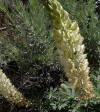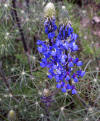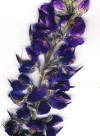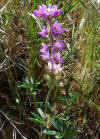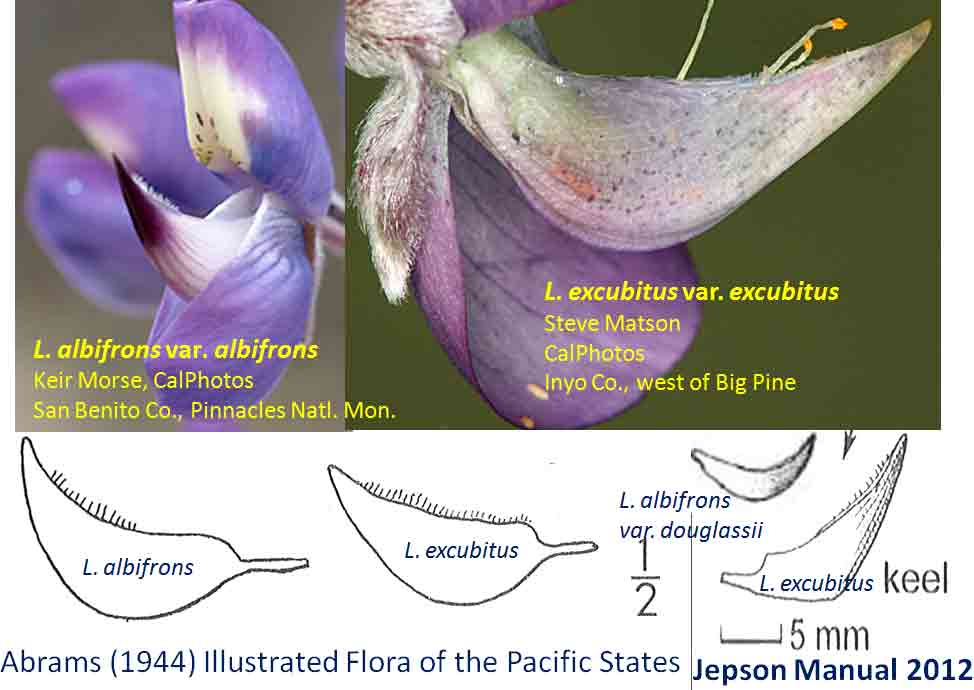|
Lupinus albicaulis
|
  Lupinus albicaulis
|
Lupinus albifrons
|
|
|
Lupinus albifrons
|
Lupinus albifrons
|
Lupinus albifrons and L. excubitus, Aug 2016. Consortium of California Herbaria records, Kern County, Berkeley Mapper. |
Lupinus albifrons
|
|
Lupinus arbustus
|
Lupinus arizonicus
|
 
Lupinus austromontanus
|
Lupinus benthamii
|
|
Lupinus bicolor
|
Lupinus breweri
|
 
Lupinus breweri
var.
bryoides
|
Lupinus breweri
var.
grandiflorus |
|
Lupinus concinnus
|
  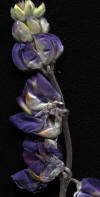
Lupinus excubitus
var. excubitus |
Lupinus excubitus
var. excubitus |
   Lupinus excubitus Kern Co., CA. Piute Mt, Kelso Valley region, Harris Grade, occurring in gray pine-pinyon pine-Joshua tree woodland with chaparral of Arctostaphylos viscida ssp. mariposa, Cercocarpus betuloides, Fremontodendron, Hesperoyucca, Penstemon incertus, 5800 ft. 14 June 2016
|
  Lupinus excubitus
var. excubitus
|
Lupinus
excubitus var. excubitus
|
|
Lupinus
excubitus (Keel ciliate, abruptly contracted to base but not
lobed)
|

Lupinus grayi |
Lupinus latifolius
|
Lupinus latifolius
|
 Lupinus
latifolius var. parishii
|
 Lupinus latifolius var. parishii California. Greenhorn Mts, in Kern Co., E slope of Sunday Peak, red fir-white fir forest, 7000–7500 ft., 7 Jul 2016 |
   
Lupinus latifolius var. parishii
|
  Lupinus lepidus var. confertus. Mt. Pinos, Kern/Ventura Co., CA. 13 July 2016. Upper photo by Suzanne Weller |
Lupinus microcarpus.
|
|
Lupinus nanus
|
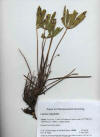 Lupinus polyphyllus Alaska. 5 miles north of Cantwell. Spjut & Marin 15508, 27 July 2003
|
Lupinus sp.
|
|
|
Lupinus. Annual to perennial herbs, subshrubs, or shrubs with usually digitately divided leaves, terminal racemes or whorls (verticels) of flowers, and dehiscent fruits (legumes). Leaves deciduous, alternate above base, the petiole distinct, dilated basally, leaflets 3–17. Flowers clustered along stem in verticels in which they arise at the same level around the stem, a whorled arrangement, or slightly at different levels within a verticel, an irregular or subwhorled verticel, or mostly alternate, the arrangement when uniformly distributed referred to as racemose; individual flower bilateral (papilionaceous) with 5 petals, differentiated as banner separated from two lower petal wings generally joined at margins surrounding a keel that may be partially exposed, banner grooved down the middle, the sides reflexed backwards like elephant ears, often centrally differentiated by color (“banner spot”), subtended by a bilateral calyx. ±267 species, not easily distinguished, concentrated in Mediterranean climate regions (not in Australia). Contains toxic alkaloids; 17 species reportedly used in native American medicine, uses relatively few for each species, frequently mentioned—blisters (especially from poison ivy), nose bleeds, and eye medicine prepared from pounded seed in water (Moerman); 208 extracts screened by the NCI for antitumor activity prior to 1980, only one active (PS tumor assay) from aerial parts of L. micranthus Gussone 1828 (NCI record name, L. hirsutus L.) collected in Kenya. Parts of the lupine flower might be compared to a sail boat, the banner representing the sail, the hull formed from two lateral wings, and the keel of two fused petals, which in the boat is below the hull, but in the lupine flower is covered by the lateral wings. Key characters involving hairiness and shape of the keel best seen by removing the wings. Tom Chester presents labeled photographs for key floral characters of Lupinus. Illustrations for most species can be found in Abrams (1944, by Charles Piper Smith) and in JM2 and Jepson eFlora. Many California perennial species of Lupinus are not clearly differentiated, including two woody species in Kern County, L. albifrons and L. excubitus, together referred to as the L. albifrons species complex (Huang & Friar 2011). For example, Lupinus excubitus was initially considered a rare species confined to Inyo County (Jepson 1919, 1936; McMinn 1939). Its circumscription has since broadened to encompass five varieties (Sholars in JM1, JM2, eFlora), many of which overlap geographically and morphologically with L. albifrons that includes three to five varieties (Smith in Jepson 1925, Abrams 1944, Munz 1959, Sholars supra); the overlap appears greatest in Kern County where most California floristic subregions and geologic provinces merge, which borders on where L. albifrons reaches its greatest diversity—in the Transverse Ranges (Huang & Friar 2011). It may be further noted that Jepson (1936) transferred the varieties of L. excubitus to L. albifrons and distinguished the species only by geography. A phylogenetic analysis of DNA chloroplast genes of the Lupinus albifrons complex obtained from ten widely scattered locations in California—that included 15 other related perennial species totaling 31 taxa—found that L. excubitus var. excubitus plants from the Eastern Sierra Nevada and var. hallii plants from the San Gabriel Mountains grouped into a distinct clade separate from all the other samples of perennial species and varieties of the L. albifrons complex (Huang & Friar 2011). Except for L. paynei discussed below, the species and varieties within L. albifrons group were not clearly separated. It was suggested that the whole subgroup be regarded a single species, L. albifrons with no varietal distinction (Huang & Friar 2011). Additionally, the Albifrons group included a clade of annual species, L. nanus and L. bicolor, ‘nested within the western North American perennial species, essentially splitting the perennial species into two main main clades’ (Huang & Friar 2011); however, Drummond et al. (2012) showed the annual species (nanus, bicolor, pachylobus) in a sister clade to the perennial species nested within an overall phylogeny (tree, 122 species) of the genus (~267 species), in which they suggest that the perennial species were derived from lowland annual species spreading into montane environments. It should be recognized that phylogenetic interpretations from molecular data that involve more intensive sampling of closely related species within a genus—represented by multiple samples of each species or variety from different locations (Huang & Friar 2011)—can reveal more complex relationships, in contrast to limited sampling that may exhibit species resolution (Drummond et al. 2012). For example, in the Huang and Friar study (2011), only two perennial lupine species were distinguishable in the Albifrons group of 16 morphologically defined species, L. albifrons and L. paynei, in contrast to eleven of the same morphological species differentiated across four internal nodes ( > .90 support) in the Drummond et al. (2012) study (excubitus, latifolius, formosus, albifrons; albicaulis; arboreus, chamissonis; argenteus, polyphyllus, andersonii, leucophyllus). The Jepson Manual treatments by Sholars (1993, 2012, eFlora accessed Aug 2016 ) distinguished varieties within the Lupinus albifrons complex by the crescent shaped keel (relatively narrow, tapering gradually to base and apex, L. albifrons), in contrast to a “lobed” keel (relatively broad, abruptly tapered to base, L. excubitus); however, this difference is preceded by two of the varieties distinguished by the absence of hairs on the banner, L. excubitus var. austromontanus and L. albifrons var. collinus, or by the lack of hairs along the upper margin of the keel, var. collinus; the latter then distinguished by the smaller flowers (10–16 mm vs 14–18 mm; Jepson 1936; JM2, Jepson eFlora).
Comparison of photos and illustrations of Lupinus
albifrons var. albifrons
It is not clear whether L. albifrons (not lobed) and L. excubitus (lobed) Sholars (supra) could be first separated by the keel lobed vs. unlobed character; apparently, this character is not entirely reliable, or their character attributes are not exclusive to each species (Huang & Friar 2011). The keel of L. austromontanus Heller (1905), for example, was originally described to be moderately curved, 3 mm across the middle, narrowed to base and apex, and slightly bearded just below apex;” thus, not lobed, which is evident in a CalPhotos image (2016) by Steve Matson (L. excubitus var. austromontanus), the species reported by Heller (1905) as “plentiful in the fields near the town of Tehachapi” (images by Steve Matson, 2016), the type locality; however, var. austromontanus is described to have inflorescences 14–40 cm (Sholars supra), and originally indicated to be without flowers along the lower half of the floral stem (Heller 1905). This is in contrast to the shorter inflorescence described for var. johnstonii, 3–14 cm long (Sholars supra). Nonetheless, the keel shape is probably the same in both varieties considering their similarity in habit and other floral features. The two varieties intergrade (Jepson 1936). Flowers shown of plants on CalPhotos identified L. albifrons var. albifrons, image by Keir Morse, San Benito Co., and L. excubitus var. excubitus, image by Larry Blakely, Inyo Co., appear so similar that it is difficult to consider them as different species, or even taken from different plants, the similarity extending to the spots within the banner spot, and to the reddish pigmentation on the keel. Jepson (1936), who noted the distinction of L. albifrons and L. excubitus by keel lobing, treated all their varieties under L. albifrons, while it remains to be determined just what character feature identifies L. excubitus as a species of the Southeastern Sierra Nevada, or as a species extending to the San Gabriel Mountains if the var. hallii clade is included as proposed by Huang & Friar (2011). Among 15 related species that evidently are not clearly separated from L. albifrons by molecular data (Huang & Friar 2011), five occur in Kern County: L. andersonii, L. albicaulis, L. formosus. L. latifolius, and L. polyphyllus. As noted above, all may be regarded L. albifrons without further varietal distinction (Huang & Friar 2011), or andersonii, formosus, and adsurgens may be included under L. albicaulis (Jepson 1936); however, it also seems likely that the gene sequences employed were not sufficiently discriminatory to differentiate all the perennial taxa; molecular ITS data for taxonomically complex genera often support only higher level classification within a genus such as sections or subgenera; e.g., Ceanothus (Hardig et al. 2000), Quercus (Murphy & Potter 2015). CCH data in the Berkeley Mapper show L. albifrons and L. excubitus overlap considerably in their geographical range throughout Kern County, which may in part be due to collectors or annotators using different taxonomic treatments, misidentifications, and/or different curatorial practices. Twisselmann recognized L. albifrons without varietal differences to occur in the foothills of the mountains surrounding the San Joaquin Valley and Erskine Canyon, and two varieties of L. excubitus, var. excubitus to occur on Mt. Pinos and along the eastern slopes of the Greenhorn and Piute mountains extending to the Mojave Desert, and var. austromontanus to occur in Jeffrey pine forests of the Sierra Nevada and Tehachapi Mountains. Moe (2016) account of lupines in Kern County are largely based onTwisselmann who identificatied them according to the treatments in Munz and Abrams. Another shrub species, Lupinus paynei, may occur on the Carrizo Plain in San Luis Obispo County, judging from images by Richard Spjut, tentatively identified L. excubitus (CNPS Kern Chapter Field Trip, 14 Mar 2014) compared with those shown on CalPhotos by Tony Morosco reportedly taken in Simi Valley (24 Mar 2008) and with those published by Davidson (1918) of an large plant ~4 m in diam. Additional images of L. paynei on CalPhotos and in Davidson (1918) show more robust inflorescences; it may be noted that the species exhibits “high genetic diversity” (Huang & Friars 2011). Huang and Friars (2011) resurrected the species because plants in the Santa Susana Mountains and Simi Hills of Ventura County were genetically distinct within the Albifrons clade; the type from “Sierra Madre Los Angeles,” also reported to occur at La Cresenta in Los Angeles County (Davidson 1918), described as a shrub 4–8 ft high with a trunk-like base to 20 cm in diam., “narrow leaflets thinly hairy on both sides,” “flowers subverticillate ,” “white through lilac and lavender to purple” with “keel ciliate.” Davidson (1918) compared it with L. longifolius “from which it differs in being silvery-pubescent, having proportionally longer and stronger semi-persistent stipules, yellow spotted standard, and canescent pod, the latter in L. longifolius is markedly hirsute or pubescent.” Davidson also indicated that L. longifolius flowers continuously throughout the season, in contrast to a short spring flowering period for L. paynei. Although molecular data on lupines—in the phylogeny of Huang and Friar (2011)—indicate that many perennial species in Kern County could be referred to L. albifrons, in the absence of such data for Kern County—except for two locations—Indian Wells Canyon (var. excubitus) and Walker Pass (var. excubitus), one is left with morphological data. Also, many specie/varieties in the molecular study were not sampled from the type locality, for example, L. excubitus var. austromontanus samples were from the Peninsular Ranges and from near Gorman, whereas the type is from near Tehachapi in the Tehachapi Mountains. Variety austromontanus plants at the type locality might be more closely related to plants in the southeastern Sierra Nevada that define the L. excubitus clade. Keys and descriptions were prepared from review of literature in consultation with images of herbarium specimens (Consortium of the Pacific Northwest Herbaria, SEINet, Aug 2016), CalPhotos, and other Internet images. Since the keel lobe vs. unlobed character may not be entirely reliable for distinguishing all species/varieties within the L. albifrons complex (Jepson 1936; Huang & Friar 2011, Sholars in JM2), an additional character is employed based on the angle of which pedicels spread from the floral stem <60º (L. excubitus) vs. >60 º (L. albifrons). This seems to show some correlation with geography even though identifications may be based on the shape of the keel. All perennial herbaceous species in Kern County develop a woody taproot or rhizome. Key to subshrubs and shrubs of Lupinus in Kern County 1 Plants distinctly shrubs or subshrubs, stems often woody above base................ 18
1
Plants mostly herbaceous, or with woody stems only at base, or
2.
Plants in low mounds or loose mats, broader than high; flowers
2.
Plants with erect to ascending leaves or leafy stems, usually taller
than
3 Flowers alternate (racemose, pedicels < 3 mm)........ Lupinus lepidus var. confertus 3. Flowers ± in whorls, or in separated clusters along floral stems............................ 4
4
Inflorescence cyclindrical, verticels >3; pedicels > 3mm;
4.
Inflorescences subcylindric to nearly head-like (capitate), usually with
5.
Banner hairy on back, especially in bud; Kern Plateau, Bartolas
County, 5. Banner lacking hairs ............................................................................................. 6
6.
Leaflets 6–20 mm; flowers 6–9 mm; north slope of Sunday Peak,
6.
Leaflets 3–5 mm; flowers 4–7 mm; summit of Mt. Pinos, Sawmill Mt.,
7 Leaflet hairs appressed.................................................. Lupinus austromontanus 7 Leaflet hairs spreading, especially visible from leaflet margins....... Lupinus grayi
8 Calyx bulged, spur-like; perennial, variable in habit Lupinus arbustus 8 Calyx without bulge............................................................................................... 9
9. Moist places...................................... ................................................................... 10 9. Dry places..................................................... ....................................................... 11
10.
Leaves well-developed at base, less so on stem, the basal petioles
erect,
10.
Leaves best developed on stem, increasingly larger up the stem,
...... Keel
exposed.....................................................................................
var. parishii
11. Flowers in regular whorls.. ............................................ Lupinus microcarpus-12
11.
Flower verticels with some individuals in a verticel appearing
12
Verticels uniformly separated with horizontal spreading pedicels,
flowers
13.
At relatively low elevations, < 3200 ft (975 m), annual appearing bushy; 13. At elevations above ≥3200 ft (975 m).............................................................. 14
14
Banner with a short nipple-like fold near apex (where reflexed along
midline),
14
Banner midline not apiculately lobed; inflorescence bracts deciduous,
15.
Leaflets densely covered with silvery hairs, relatively narrow elliptic,
15
Leaflets generally green, folded or not folded, usually widest above
16
Basal leaves present, often many, crowded, the longest with petioles
16
Leaves mostly on stems above base (“cauline”), the longest on petioles
17
Banner not hairy on back, keel not ciliate, often curved upward 17 Banner hairy on back; keel ciliate on upper margins, not exposed..................... 20
18.
Stems mostly branched and leafy near base, ascending or spreading
18
Stems simple or branched and leafy above base; ascending to erect
19.
Stems mostly simple, occasionally with secondary floriferous 19 Stems branched—with shorter sterile leafy shoots ................. Lupinus formosus
20.
Plants with most of the following: leaves silvery (except var. hallii);
20.
Petioles 1–4 (-5) cm; inflorescences not clearly verticillate,
21. Flowers 9–14 mm long............................................ L. excubitus var. excubitus 21. Flowers 14–18 mm long................................................ L. excubitus var. hallii
22. Keel ciliate along upper margins from mid region to apex..... Lupinus albifrons 22. Keel mostly without hairs, reported from Kern County..... Lupinus chamissonis
Lupinus albifrons Bentham 1834 var. albifrons [Includes L. eminens Greene 1893 (type: http://science.mnhn.fr/taxon/species/lupinus/ermineus); L. fragrans Heller 1834 (http://www.tropicos.org/Name/13036911)]. Bush lupine, silver bush lupine. Rounded subshrub with greenish to more often silvery leaves digitately divided into 6–10 leaflets; flowers in racemes on long flowering stems (peduncles 5–13 cm) that extend above the leafy part of the plant, violet to purple. Coast Ranges and Sierra Nevada foothills. Silver bush lupine scrub recognized in MCV2 when >50% relative cover in the shrub canopy—along river mouths, coastal dunes, bluffs and terraces. Type from California, San Diego County [possible isotype, HUH (GH), http://kiki.huh.harvard.edu/databases/specimen_search.php?fragmentid=62340]. Kern Co.: Common in the Temblor Range south to Mt. Abel, and of infrequent occurrence in the Sierra Nevada foothills to Erskine Canyon (Twisselmann), 305–2,134 m. Lupinus albifrons var. collinus Greene 1891. Low subshrub with creeping and ascending stems from 20–40 cm high; leaves clustered towards base, petioles 3–8 cm, leaflets 6–9 with appressed silvery hairs, 1–2 cm long; flowers Mar–Jun, purple to blue or violet with white, or entirely white, in sub-whorls on peduncles 6–10, scapes 4–14 cm, upper margins of keel with or without cilia. Cliffs and forest openings below 2,000 m, Oregon south along Coast Ranges and Sierra Nevada. Type from San Francisco, rocky summits about the Presidio, and on the islands in the Bay. Kern Co.: 5.0 mi NW along the N-side of Evans Road in the Greenhorn Mountains, State Highway 155, 5,000 ft (Danenhower, 19 May 1983, CCH); Southern Sierra Nevada, Walker Pass Summit along Hwy 178, 1,599 m (J. Latting, 29 May 1973, CCH). Lupinus breweri A. Gray 1868 var. breweri. Mat lupine. Low flat-topped matted subshrub < 20 cm high, usually much broader; leaves with 5–10 silvery green leaflets on petioles 1–5 cm, leaflets ascending recurved, keeled, 6–20 mm; flowers Jun–Aug, in <5 whorls on peduncles 1– 3 cm, individual flowers 6–9 mm on pedicels 1–3 mm, blue (to violet) except for white or yellow on banner; fruit 1–2 cm, silky. Open forest slopes and rocky ridges, Klamath Mountains, southern Oregon to California, Sierra Nevada and desert mountains to western Nevada south to San Gabriel, San Bernardino and San Jacinto Mountains, 1,000–4,000 m. Type from Yosemite Trail, Yosemite Valley, California. Kern Co.: “Occasional in sand around granite outcrops and in sandy openings in the red fir forest in the Sunday Peak region” (Twisselmann), 2103 m (CCH). Lupinus breweri var. bryoides C. P. Smith 1925. California. Distinguished by shorter leaflets, 3–5 mm; montane forests 2500–4,000 m, Eastern Sierra Nevada, Transverse Ranges; type from Olancha Mt., Tulare Co.. Kern Co.: “A characerstic mated plant of the exposed summits of Mt. Pinos and Sawmill Mountain, growing in extensive mat-like colonies in gravelly soil” (Twiseselmann), 2782 m (CCH). Lupinus breweri var. grandiflorus C. P. Smith 1925. California. Distinguished by the silky banner. Volcanic sand, 2000–3500 m, Sierra Nevada, San Bernardino Mts.; type from Mono Craters, Mono Co. California. Kern Co.: “Rare in colnies in the Jeffrey pine forest along the crest of Piute Mountain and on the ridges of the southern end of the Kern Plateau” (Twisselmann), 1829–2712 m (CCH). Lupinus chamissonis Eschscholtz 1826. Beach blue lupine, silver dune lupine. Shrub 0.5 to 1 (-2) m; leaves digitately divided into 6–9 leaflets on petioles ~2 cm long; leaflets silky hairy on both surfaces; flowering Apr–Jun; flowers mostly blue to lavender with a yellow center, scattered or in whorls along scape-like stems 6–15 cm long on pedicels 6–8 mm long; legumes brown, 3–3.5 cm long and 8–10 mm wide. Coastal hills from Mendocino to Los Angeles Cos, inland to Tulare, Kern and Riverside Cos. Type from “arenosis novae Californiae.” Silver dune lupine—mock heather scrub recognized in MCV2 when conspicuous with Ericameria ericoides—along coastal dunes. Kern Co.: Not in Twisselmann or Moe. CCH : Tehachapi Mts., margin of barren volcanic bedrock areas on small hill about 0.5 miles north from the A. D. Edmonston Pumping Plant of the California Aqueduct (D. W. Taylor & Plamer, 22 Mar 1987, RSA); Bodfish Rd., east of Caliente, ~3,000 ft (Runyan, 22 Mar 1973, RSA); Kelso Valley (Zigmond, without date, RSA); Jawbone Canyon (Zigmond, without date, RSA); Kern River 2,770 ft (Peirson, 13 May 1930, RSA). Images in CalPhotos suggest this plant could be prostrate or erect. Sholars (JP2) distinguished the species from others by the erect shrub habit , at least 40 cm high, and up to 2 m, and by its habitat in being confined to coastal sand dunes not more than 10 m in elevation. This interpretation follows Jepson (1936) who separated L. excubitus and L. albifrons from L. chamissonis by habitat and geography, Coast Range and west slope of Sierra Nevada for L. albifrons, Inyo Co. for L. excubitus, and coastal dunes for L. chamissonis. Abrams (1944) distinguished L. excubitus by the keel not being narrowed to base and L. albifrons by the lower petioles being much longer than their leaflets in contrast to L. chamissonis having petioles—2 cm long—nearly equal to the leaflets. The CCH records suggests that this species may not be strictly coastal. Lupinus excubitus M. E. Jones 1898. Grape soda lupine. Similar to the preceding, differing in its more southern distribution and by the keel of the flower being lobed near base; leaflets 7–10, 5–50 mm. Four shrub and subshrub varieties: var. excubitus Desert slopes, washes below 8,000 ft. Mojave Desert and eastern slopes of Sierra Nevada, up to 8,000 ft. Type from Lone Pine, Inyo Co., CA, Jones s.n., MO-256274 (isotype), Tropicos, http://www.tropicos.org/Name/13010602. Kern Co.: “Common on the arid desert-facing slopes of the mountains; east to the El Paso Range; west to the arid east slopes of the Piute Mountains and the Greenhorn Range, and southeast to the Mt. Pinos region. In the desert canyons large colonies grow on the steep often barren talus slides; here the plant with its rich royal blue flowers is one of the more spectacular sights of a desert spring. Particularly fine colonies grow in Horse Canyon on the east slopes of Kiahvah Mountain and in the Nine Mile Canyon in extreme southern Inyo County” (Twisselmann). CCH records from the Owens Peak Eastern Watershed. East: end of Five Fingers, Indian Wells Canyon, Short Canyon; Buena Vista Canyon, Grapevine Canyon, Mt. Jenkins; canyon north side of Pinyon Peak ~4 air miles northwest of Walker Pass, Scodie Mts.; Tehachapi Mts. Cameron Road between Tehachapi and Mojave; State Highway 178, Walker Pass Trailhead; 2.2 road mile SW of Jawbone Canyon. turnoff, ca. 3.5 air miles. ENE of Chuckwalla Mt.; far west end of the San Emigdio Mountains, Bitter Creek National Wildlife refuge; E-side of Kern River Road at the Hospital Flat Campground Kernville var. austromontanus (Lupinus austromontanus A. Heller 1905) C.P. Smith 1925. Mostly herbaceous; leaves clustered at base, reduced upwards to 1–3 leaves. Open fields, grassy slopes; 1,000–3,000 m. Tehachapi Mts., San Gabriel Mts. and San Bernardino Mts. Type from Tehachapi, Kern Co., CA, A. A. Heller 7825 (MO-357104, http://www.tropicos.org/Name/13010309). Kern Co.: “An herbaceous form that most commonly grows in the Jeffrey pine forest from the southern Kern Plateau, the Piute Mountains, and Breckenridge Mountain south through the Tehachapi Mountains.” “An extensive colony grows in Upper Sonoran grassland at the summit of Oak Creek Pass between Mojave and Tehachapi” (Twisselmann). CCH records from Oak Creek Pass, Kern River Hospital Flat Campground, east slope of Piute Mt., Scodie Mountains: Kiavah Wilderness, head of Horse Canyon; Greenhorn Range, 5 mi southwest of Eugene Grade; Unpaved road 1/2 mile north of Phillips Rd; Chuckwalla Canyon, ca. 1 mile SE of peak; 4.5 mi. east of Claraville on road to Kelso Valley; Tomo-Kahni (Creation Cave) State Historical Park, NE of Monolith and Tehachapi, near intersection of Sand Canyon and Tranquility Roads; Tehachapi Pass; Mt Pinos at 8200ft above Cuddy Valley; Caliente Canyon; San Emigdio Mountains Region; Sawmill Mountain ~ 0.25 mi southwest of the entry to Mil Potrero Park, west of Pine Mountain Club; 319–2,203 m. var. hallii (Lupinus hallii Abrams 1910) C.P. Smith 1925. Recommended name: Lupinus paynei Davidson 1918 (Huang and Friar 2011); isotype HUH (GH), http://kiki.huh.harvard.edu/databases/specimen_search.php?fragmentid=81239. Larger and coarser than the typical variety, particularly the flowers, 14–18 mm. Sagebrush scrub below 5,000 ft. San Gabriel Mts., San Bernardino Mts., Peninsular Ranges. Type for var. hallii from Reche Canyon, San Bernardino Co., CA. Kern Co.: Kernville; 31.5 mi from Woody, or 7 miles from Glennville along Hwy 155; 609–853 m (CCH). This may belong to var. excubitus. Lupinus paynei is restricted to within 10 miles of Simi Valley. var. johnstonii C. P. Smith 1925. Low subalpine shrub, less than 15 cm high, with densely branched woody stems. Understory shrub in pine forests, 5,000–8000 ft,. San Gabriel Mts., San Bernardino Mts. Transverse Ranges. Type from Baldy Lookout, San Antonio Mts., Los Angele3s Co., CA. Kern Co.: Mt Pinos region Frazer, Mountain; North slope, high road shoulder, 7,000 ft; Tehachapi Mountains, Tejon Quad., 1,523–2,134 m (CCH).
|
|||


